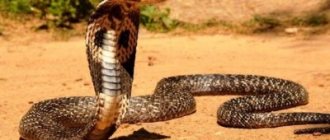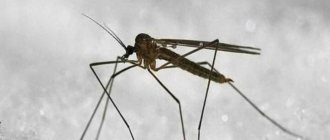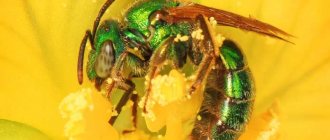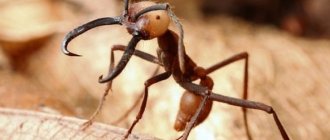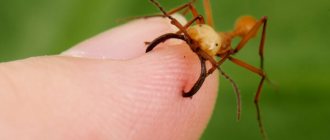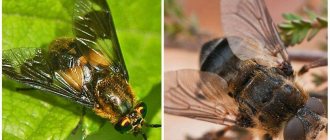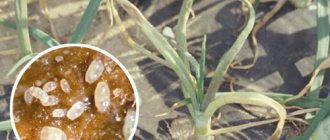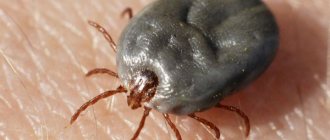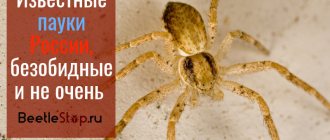Several residents of Sochi posted messages on social networks about huge spiders entering their homes. According to the Yugopolis portal, photographs of local residents show that the abdomen of such spiders is “the size of a walnut,” and the legs “reach five to seven centimeters.” As it turned out, the insects belong to the family of araneomorph spiders, they are also called pseudotarantulas or wolf spiders.
Arachnologists associate the penetration of spiders into residential buildings with warm weather conditions this year. Candidate of Biological Sciences, senior researcher at the Southern Scientific Center of the Russian Academy of Sciences (SSC RAS), arachnologist Alexander Ponomarev believes that wolf spiders could crawl into people’s homes due to the mating period that had begun.
“This year’s autumn turned out to be very warm and protracted, and perhaps the spiders’ breeding season has begun. In search of a partner, spiders can run into houses, since their numbers are high. This is the only explanation. They will not spend the winter in houses. Wolf spiders live in places with high levels of humidity, usually in forest areas located near water bodies,” Ponomarev told AiF.ru.
Hogna radiate. Photo: Commons.wikimedia.org
What are wolf spiders?
Hogna radiate, pseudotarantulas or wolf spiders are a family of araneomorphic spiders. These are quite large arthropods; in some cases their size can exceed 30 millimeters. There are 2,367 species of such spiders in total. Most often they can be found in countries with warm climates.
Pseudotarantulas live in grassy meadows, bushes, among fallen leaves and under stones, and the most favorite places are places with a high degree of humidity - forests located near water sources. Spiders live in burrows, shrouded inside in a thick layer of web; they leave their home at night to hunt insects or other smaller spiders. These spiders do not weave webs directly as traps.
Another feature of these arachnids is their peculiar body coloring and amazing ability to camouflage, merging with the environment. In nature, the most common spiders have a brown, gray or black body.
Question answer
Where did karakurt spiders come from in the Moscow region and why are they dangerous? Spiders of this species have eight eyes arranged in three rows. They allow arthropods to detect prey at a considerable distance. The limbs of spiders have 48 knee bends. The surface of the legs, covered with special hairs, helps spiders hunt.
Pseudotarantulas prey on cicadas, small forest bugs, beetles, mosquitoes, aphids and other small insects. Most spiders quickly move along the surface of the soil in search of prey; some individuals can ambush it, instantly jumping at it.
Wolf spiders are natural stabilizers of the number of harmful insects and plant parasites, and therefore play a very important role in the balance of the ecosystem. They also destroy a huge number of pests of various gardening and ornamental flowering crops.
The average lifespan of a wolf spider can vary depending on size and species characteristics. As a rule, the smallest species live no more than twelve months.
Hogna radiate. Photo: Commons.wikimedia.org
What poisonous spiders can you find?
There are many poisonous spiders living in the Krasnodar Territory. Some representatives with their bite can lead to instant death.
There are many types of poisonous spiders
Karakurt
Karakurt prefers arid areas. Lives in burrows underground. Does not behave aggressively towards people. In most cases, a karakurt attack occurs by accident when a person does not notice the insect in shoes or on things. In this case, the spider bites for protection.
After a bite, the skin swells. There is severe pain and redness. Within 10 minutes your overall health deteriorates. The following symptoms appear:
- nausea and vomiting;
- painful sensation in the head and stomach;
- muscle spasms;
- difficulty breathing;
- increased blood pressure;
- fainting state;
- rapid pulse;
- weakness;
- lack of appetite;
- rashes on the skin.
If first aid is not provided in a timely manner, cardiac arrest occurs.
The female reaches 2 cm. Males are smaller. Young spiders are more active. Gradually the color becomes more uniform. Young insects have dark spots on their bodies.
Karakurt is very dangerous
Are pseudotarantulas dangerous for humans?
These spiders are not dangerous to humans. On the Internet you can see many videos in which, upon contact with a person, a wolf spider runs away and does not attack. Wolf spiders are calm predators, but if they are continuously disturbed, they can bite.
“There is one species in Sochi, Hogna radiate lives there. This type of arthropod is not at all prone to attacking warm-blooded animals or people. In principle, it can bite through the skin, but there will be no serious, negative consequences,” says Ponomarev.
A spider bite may only cause itching, redness, or short-term pain.
The most dangerous and unpleasant creatures that can be found in Sochi
Don’t go into the forest, there are ticks and there may be bears - many people know about these dangers that can await you in a wooded area. However, there are other living creatures in Sochi that can cause significant harm to your health.
Snakes
The chance of meeting a snake in Sochi, unfortunately, is very high. However, do not rush to get scared, such terrible cold-blooded animals as the reticulated python and anaconda live far beyond the Caucasus. According to scientists, the length of local snakes rarely exceeds 1 meter. Poisonous ones take advantage of opportunities to attack prey during the hunt. They do not set up special ambushes to harm humans.
In the vicinity of Greater Sochi you can find:
- Viper. Their length does not exceed 70-80 cm. How to recognize? The head is vaguely patterned and the long, mobile body is gray or brown. These snakes are calm and do not attack first. They appear extremely rarely in populated areas, only randomly. They are not susceptible to swimming in the sea; they never appear in open areas, preferring thickets and secluded places;
- Cottonmouth. This reptile loves to live in river valleys, including mountain ones. The usual body dimensions of this snake do not exceed 70 cm in length. The coloring is colorful: brown areas of the skin are adjacent to gray patches. Fortunately for us, the copperhead tries to stay away from cities, and is also indifferent to swimming in the sea.
- An ordinary snake. This reptile is absolutely non-venomous. A distinctive feature of the snake is its yellow “ears.” Some individuals can reach large sizes, exceeding 1 m in length. They prefer to hide from humans in the depths of another clearing, rich in wet, withered foliage.
Ticks
Who among us doesn’t love outdoor recreation? When going on a hike or a regular walk through the forest, don’t forget about the arthropods that are just waiting for your appearance. Massive tick attacks last from April to July. Therefore, you can already exhale a little, but vigilance will not hurt.
In addition to encephalitis, ticks are carriers of other diseases. For example, borreliosis. This disease affects the muscles, joints, heart and nervous system, and if left untreated, you can become disabled.
Most often, ticks can be picked up in tall grass, boxwoods, and riverine vegetation (alders, ferns). It’s better to go into the grass and go around the bushes.
Spider
Along the seashore you can find a spider - karakurt. It lives where there are coastal cliffs. The South Russian tarantula also comes to us, which is especially common in the Lazarevsky district. These species are quite poisonous. But they themselves do not attack animals or humans unless they are disturbed. These types of spiders do not crawl into cars or houses themselves. The tarantula lives in holes in the ground, and the karakurt lives under stones.
Jellyfish
If you go to the sea, you can always see the following picture - the joyful face of a vacationer, who is clutching pieces of transparent whitish jelly in his hands. It is also unsafe to do this. The resort is home to jellyfish, which can cause serious, painful burns. There is a small, four-centimeter cross jellyfish. The burn can be caused simply by touch. People prone to allergies will feel it more.
Tags: ImportantSnakesInsectsDangerous reptilesDangerous reptiles Sochi
What insects are found in Kuban?
The question is not only for tourists who want to go on vacation safely without contracting any infection, and simply not suffer from mosquitoes. After all, there are many other, more dangerous insects. For example, malaria flies, which can become carriers of a dangerous disease, spiders - tarantulas, not counting wasps and bumblebees, beetles, whose bites can cause great trouble. So, what can you encounter in Kuban?
Beetle Beetle
Blister beetle - it got its name because of the result that occurs on the human body after an attack by a beetle. The bite site soon swells and an abscess or blister forms. The outside of the beetle is bright and quite large, so keep an eye on children so that they stay away and do not accidentally eat it, because the Blister is poisonous. It is its poison that causes such reactions on the skin, and if ingested, it can lead to death. Fortunately, it is easy to spot due to its unusual coloring.
Ringed scolopendra
The ringed scolopendra is a rather large creature for an insect; it arouses sympathy among few people. The centipede has poisonous jaws and loves dark and damp places under coastal stones. Its length is up to 15 cm. Its poison affects the composition of the blood, the lymph nodes swell and the pain lasts for several days
So be careful. Do not confuse the scolopendra with the flycatcher
She is smaller in size and has a different appearance. Such centipedes can be found in any home.
The wolf spider is considered the largest spider in the region. The paw span is 3-4 cm, a relative of the karakurt. Poisonous.
South Russian tarantula
The South Russian tarantula is not always found in the Kuban, but it can “wander in for a visit.” Large, 35mm, has thick wool. It is poisonous, the bites are painful and the pain lasts for several days.
Argiope spider
Argiope spider - naturalists value it more than others for its beautiful coloring. Silvery with white belly, notches with beautiful streaks. There are multi-colored stripes on the paws. Fortunately, this coloring makes it noticeable. Poisonous!
My beast: how the poisonous spider Karakurt settled in Kuban
“Notebook Krasnodar” talks about animals that live in the Krasnodar region. Next up is the Karakurt spider, which belongs to the black widow family.
This spider, despite its small size, is very dangerous. Its bite can lead to death.
How to identify this little messenger of death? Karakurt females reach sizes up to 2 cm, and males and small individuals up to 1 cm. They have characteristic red spots with a white edge on their body. There are 13 of them. However, adult individuals may not have such spots. But this type of spider has no hair at all. Only females pose a danger to people, since males are simply not able to bite through human skin.
Where do they mainly live? Karakurts mainly love steppes and deserts. However, as a result of global warming, these spiders began to settle en masse in Russia, in particular in the Krasnodar Territory. It’s true that spiders live only in dry places where people usually don’t go. Black widows prefer to settle in the burrows of voles, dry piles of old garbage, in stone rubble and cracks.
“It used to be that karakurt did not wander into the Kuban, but with the onset of global warming it is no longer possible to talk about this,” says Andrey Chushkin, biologist, senior researcher at the field research laboratory of the Krasnodar State Historical and Archaeological Museum-Reserve named after Felitsyn. - Moreover, Kalmykia is not far away, where such spiders are a common sight. Now it is also found in Crimea. And individual individuals were found even in the Moscow region.
As we have already noted, only Karakurt females are dangerous. You should be especially careful in June-July, when they have mating season. Most often, it is at this time that bites occur.
The male attracts the female with fragrant pheromones. But the life of a male is short. Immediately after mating, the spider eats its partner. Raising the offspring falls entirely on the shoulders of the “mother”. On average, the number of eggs reaches 130 pieces. With the arrival of autumn, the female dies.
Offspring are born in April. However, the cubs do not immediately leave their shelter. First, they eat all the supplies that their mother left for them, and then they begin to eat their brothers. The “law of the jungle” already applies here - survival of the fittest. A year later, the spiders emerge from the cocoon next spring and become sexually mature in June–July.
What do Karakurts eat? The black karakurt feeds on insects that fall into its nets. These are usually those types of arthropods that live directly next to the spiders themselves: beetles, grasshoppers, locusts, flies and horseflies. It is interesting that the victims of karakurts are caught in horizontally stretched nets. At the same time, the web of karakurts is not distinguished by the grace of circular lines, but is made as if randomly, but at the same time it is very viscous and does not give the insect caught in it any chance of salvation. The spider paralyzes the caught insect with poison and then sucks out its liquid tissue.
How can you recognize that you have been bitten by a karakurt? At first you won't feel anything. You may feel severe pain within 10-15 minutes or within an hour. All the muscles of the body begin to ache, as happens with the flu or other colds. The muscles that hurt the most are the chest, abdominals, and lumbar region. In addition, the heart rate increases, shortness of breath appears, dizziness, and tremors of the limbs. After this, general weakness of the body sets in, it seems that the limbs do not obey the person, and vomiting appears. Next, nervous exhaustion occurs in the human body and depression may occur. A person’s consciousness becomes cloudy, and he ceases to be aware of reality and even recognize people close to him.
The most effective way after a bite is to immediately cauterize the wound. This allows you to destroy the poison, preventing it from spreading through the blood throughout the body. The fact is that the female bites through the skin only half a millimeter, and for some time the poison concentrates almost on the surface. And, of course, you need to seek help from specialists.
Based on materials from bloknot-krasnodar.ru
How to repel tarantulas: the most effective methods
Wolf spiders are ground hunters that hide in the shadows or dark corners during the daytime. Therefore, they can suddenly attack a person at home or in the garden. The following methods will help scare off unwanted arthropod “neighbors”:
- Clean up your garden by removing grass clippings, leaves and firewood. Get rid of empty pots, rocks and grills that can provide hiding places for spiders;
- remove plants around the perimeter of the house, replant shrubs and other above-ground plants;
- Seal cracks and holes in the outside of the wall to reduce the risk of spiders getting inside;
- Install insect screens on all ventilation openings;
- remove outdoor lighting lamps, as a large number of flies, moths and other insects that wolf spiders feed on accumulate around the lamps.
Don't forget about the internal environment:
- Vacuuming your home regularly will help remove crumbs that may attract spiders and other insects. Remove any cobwebs you see;
- throw away cardboard boxes; it is better to use plastic containers instead;
- Get rid of clutter: throw away piles of old magazines, dirty clothes, books and boxes.
Chemical treatment also plays an important role:
- use specially designed anti-spider products. For this method to be effective, it must be combined with other methods;
- Wolf spiders are best repelled by residual pesticides scattered on the ground;
- use insecticides that contain pyrothroids, deltametry, cynometry, lambda-cyhalothrin, or bifenthrin, they are most effective against wolf spiders;
- Sprinkle boric acid around the house, paying special attention to dark corners, cracks and areas under furniture.
If your home or property is infested with wolf spiders, it is best to seek the help of specially trained and licensed professionals to use more powerful chemicals.
White karakurt - Latrodectus pallidus
Image of a white karakurt
This is a white spider, with long legs and a round abdomen. The abdomen is white or milky in color, with 4 indentations. The legs and cephalothorax are yellow or light brown. The white spider has a body 10-20 mm long. Females are larger than males. White spiders weave a web in the shape of a cone, which is connected to a trapping net. They live in North Africa, the Middle East, Iran, Kazakhstan, Turkmenistan and Azerbaijan. The white karakurt spider is not aggressive, but its poison is toxic and can cause complications. Children and the elderly are most susceptible to the effects of the poison. Toxicological studies have shown that the poison of the white karakurt is similar to the poison of the karakurt (Latrodectus tredecimtugattus). If you are bitten by this spider, you should consult a doctor.

